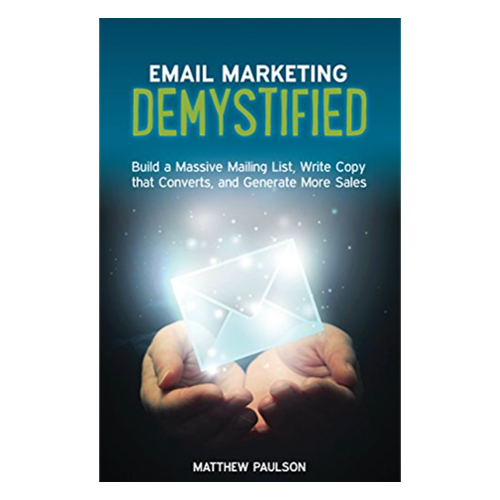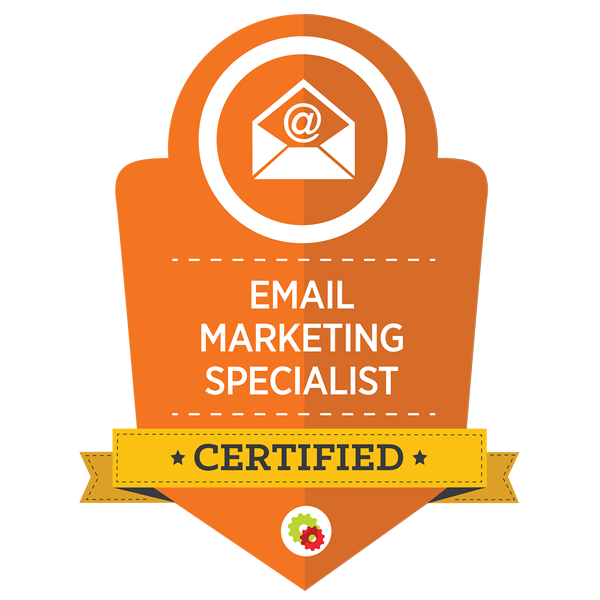Email Marketing DeMystified
by Matthew Paulson
This email marketing book is a solid and comprehensive resource full of actionable advice that definitely belongs on your shelf.
Three pages into the Foreword, John McIntyre also know as the Autoresponder guy makes an awesome analogy that I couldn’t agree with more.
He says “if marketing channels were cars, even the best social media and SEO campaigns would be like a Mercedes-Benz fast and luxurious, but certainly not the best in their class while email marketing would be a McLaren F1 or a Lamborghini Gallardo.
Email marketing doesn’t just beat everything else.
It leaves them in the dust!”
In the first chapter Matt makes one of the strongest arguments for using email marketing I’ve ever read mentioning the following points:
- It generates massive ROI and long term results
- Most customers want email from businesses
- It outperforms social media
- It’s universal
- It's resilient
- And it's NOT a monopoly!
Concluding with the statement of when you invest in email marketing, you know that the medium won’t be replaced by a bigger and better things a few years from now.
One question he poses is “I hate email and pop ups and being nagged to sign up to everyones list, why would I want to send Email Marketing messages to my audience” his response is priceless and a great reminder and that is “You are not your audience”.
In his opinion, someone who says “I hate popups and marketing email” is really saying “I hate making money".
He provides a lot of actionable advice on the types of forms you can create and how to test which ones are the most effective as well as elements to change and test for
Similar to the Cold Email Manifesto book that I also reviewed on this channel, Matt does some thing similar where he gives you action steps to complete at the end of each chapter, which I think is helpful for readers to take action, and or get unstuck.
Between some of the chapters, he shares case studies of businesses that he has either founded or worked with and ways that he has used email marketing to grow that business.
I like hearing these examples because it gives me and you as the reader relatable ways that we can use email marketing for our businesses.
In the second case study, he shares an example of a software as a service creator who uses surveys to ask his website visitors what problems they have, and what they are struggling with to create lead magnets for them based on their responses.
This is great advice if you are unsure what those might be.
He gives a great list of ways to grow your email list beyond creating lead magnets and leveraging your own blog or website traffic that are very intriguing.
One of which is email swaps where you agree to promote another business through your list and they agree to promote yours to theirs.
He gives detailed and descriptive examples of types of broadcast emails that can be sent, auto responder emails that can be sent, and engagement emails that can be sent, along with scheduling ideas to properly space out how often those emails should be sent.
These are helpful reminders of all the different ways that you can use email to communicate with your audience, provide value to them, and increase sales.
In the wrap up section of chapter 4, he mentions how getting all of these different types of emails written can be overwhelming and feel like a big chore, but he makes an important point, and that is to take small steps by just writing 1 to 2 emails at a time.
Especially when it comes to writing a big automation sequence that might be 10 to 15 or 20 emails you can just write the first few and then add one or two to it every day or two.
I wanted to point this out because when it comes to being overwhelmed with all of the things that you need to do, the struggle is real.
In chapter 5, he discusses one of the most important parts of email marketing, which is creating your customer avatar and trying to get inside the mind of the people that you are marketing to.
Thinking through what your potential subscriber does for a living, what gender they are, what their marital status is, what their living situation looks like, what hopes and fears they have, and trying to think through what problems they encounter on a daily basis.
Another book I read and reviewed called Email Persuasion by Ian Brody, also goes into greater detail about creating your customer avatar and I highly encourage you to check out that review and that book after this one.
Matt states the importance of keeping the focus on your subscribers as much as possible and making your emails about them not you.
He emphasizes using “you” based language because it will make your subscriber feel more like you were talking to them individually.
He’s exactly right in saying this, if you are the face of your business or website or blog or social media channel people subscribe to you and want to get emails from you not from a faceless company.
This is obviously different if you’re writing for a big brand like JCPenney or Amazon or Verizon because I’m not getting emails from a specific person from those companies.
Communication from these types of companies typically come in the form of transactional or promotional emails, not relational ones.
One small disagreement I have with him in chapter 5 is he mentions using the PS occasionally in your emails. I think you should use it 9.5 times out of 10, if not in every email.
He brings up a very important point about emails that provide value and emails that take value away, and discusses the importance of giving value to your subscribers more often than asking for something from them.
He suggests, as I do, to send 2 to 3 pieces of valuable content for every piece of promotional content.
He shares fantastic information about different types of subject lines that you can use to stand out in the inbox along with some handy subject line techniques, however, I choose to typically follow what Ian Brody says in Email Persuasion, which is that if you build trust with your subscribers and have a strong sender reputation, they will open your email no matter what the subject line is.
He provides examples of his own emails for writing an announcement email, an affiliate marketing email, a content promotion email, and a feedback email.
Then he gives a really helpful acronym to use as a framework for writing sales and marketing email copy.
It is called AIDA and stands for:
- Attention
- Interest
- Desire
- Action
...and further describes what each of these steps involve.
I find this framework really simple to remember and plan to implement it into my email copywriting.
He provides a great list of best practices to follow when sending any email, specifically:
- not to rely on images to convey your message since many subscribers will have these blocked
- avoiding grammar and spelling errors
- the importance of including multiple links to what you want your subscriber to click on
- avoiding design heavy email templates
- limiting each email to one call to action
- and having a clear unsubscribe link.
He outlines 6 different categories of ways to monetize your email list with corresponding subcategories of additional ideas.
There were a few on the list that I hadn’t thought of or heard about and am interested to try these in my own businesses.
Towards the end of the book, he talks about single and double opt in subscribers and makes note that single opt in mailing lists generally grow faster than double opt in and says, while they may have lower open rates and higher bounce rates, single opt in mailing lists tend to have a higher total number of engage subscribers.
I don’t agree with that.
I think double opt in subscriber lists would have much better engagement because it took more work for the subscriber to sign up to the list, and furthermore, what is the point of having a big list if you have lower open rates with it?
He provides helpful descriptions into SPF, DKIM and DMARC verification and how applicable they might be to you based on your email marketing needs.
He offers some helpful advice and tools to keep your email reputation strong by keeping your sending domain off blacklists and what you can do to avoid them, as well as how to handle if your domain gets added to one.
He shares a basic introduction to outbound marketing through cold emailing and other means to broaden the reader’s understanding of how e-mail can be used to generate business and discusses some great strategies for doing so.
If this is something you’re considering doing for your business I would highly encourage you to check out the Cold Email Manifesto which I reviewed.
It will give you an in depth course of action for using cold email to find new customers especially in the business to business space.
Overall, this is a very comprehensive resource that definitely belongs in your library.
It contains effective strategies, techniques, and advice to leverage both inbound and out bound email marketing for your business...
...I highly recommend it!
I want to give a quick shout out to my subscriber Matin for reminding me to read and review this book, it was an excellent recommendation, so thanks for that!
If you’d like to check out reviews of the other 2 books I mentioned in this video watch those here:
I hope this book review will help you.
Have a great day!
Return to top of Email Marketing Books Review
If you found this helpful, please share it and join our free Email Marketing Wisdom Newsletter for more.
- Homepage
- Email Marketing Books
- Email Marketing Books










